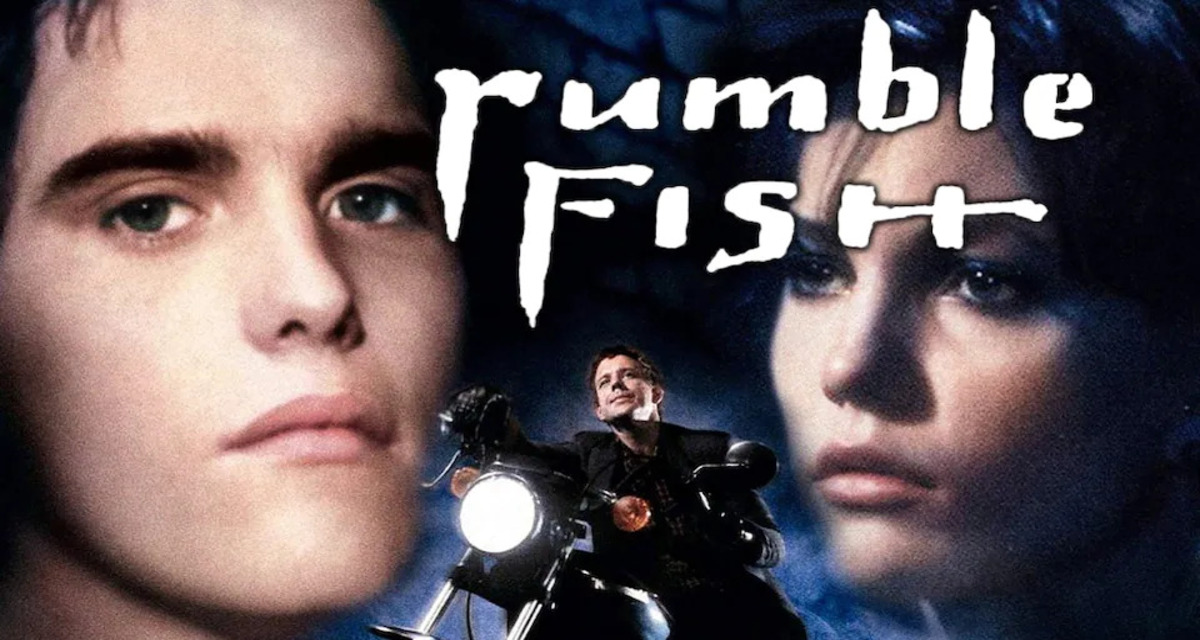
Rumble Fish is a critically acclaimed movie that has achieved cult status in the world of cinema. Directed by the legendary filmmaker Francis Ford Coppola, this 1983 film is known for its gritty portrayal of teenage angst and rebellion in a small town. Set in the 1960s, Rumble Fish follows the story of Rusty James, a rebellious teenager who idolizes his older brother, The Motorcycle Boy, and gets caught up in a world of street fights, motorcycle gangs, and inner turmoil. With its stylish black and white cinematography and a stellar cast, including Matt Dillon, Mickey Rourke, and Diane Lane, Rumble Fish remains a captivating and thought-provoking movie that delves into themes of identity, family, and the search for meaning in a seemingly chaotic world. In this article, we will explore 45 fascinating facts about the making of Rumble Fish that will give you a deeper appreciation for this cinematic gem.
Key Takeaways:
- Rumble Fish, a 1983 movie, explores sibling relationships, youth rebellion, and the allure of danger. Its black and white cinematography and haunting score create a mesmerizing and timeless cinematic experience.
- Directed by Francis Ford Coppola, Rumble Fish delves into themes of identity, self-discovery, and the consequences of broken dreams. With a stellar cast and visually striking elements, it remains a cult classic.
The movie Rumble Fish was released in 1983.
Rumble Fish, directed by Francis Ford Coppola, hit the silver screen in 1983, captivating audiences with its unique storytelling and stunning visuals.
It is based on the novel of the same name by S.E. Hinton.
Rumble Fish is adapted from the novel written by S.E. Hinton, who also wrote the popular novel “The Outsiders,” which was also made into a movie.
The movie features a stellar ensemble cast.
Rumble Fish boasts an impressive cast including Matt Dillon, Mickey Rourke, Diane Lane, Dennis Hopper, and Nicolas Cage, who deliver powerful performances that bring the characters to life.
The film is shot entirely in black and white.
One of the standout features of Rumble Fish is its visually striking black and white cinematography, which adds to the gritty and atmospheric feel of the movie.
The score of the film is composed by Stewart Copeland.
Stewart Copeland, the drummer of the band The Police, created the haunting and atmospheric score for Rumble Fish, perfectly complementing the film’s tone and mood.
The movie explores themes of alienation and youth rebellion.
Rumble Fish delves into the struggles faced by teenagers in a small town, highlighting their desire for identity, independence, and the consequences of their actions.
Nicolas Cage and Francis Ford Coppola are related.
Not many people know that Nicolas Cage, who plays a pivotal role in the film, is actually the nephew of director Francis Ford Coppola.
Rumble Fish was not a box office success.
Despite receiving critical acclaim, Rumble Fish did not fare well at the box office, but over the years, it has gained a cult following and is regarded as a cult classic.
The movie was filmed on location in Tulsa, Oklahoma.
Tulsa, Oklahoma serves as the backdrop for Rumble Fish, adding an authentic touch to the story’s setting and atmosphere.
Rumble Fish explores the complexities of sibling relationships.
The movie delves into the complicated dynamics between Rusty James (played by Matt Dillon) and his older brother Motorcycle Boy (played by Mickey Rourke), showcasing their love, loyalty, and conflicts.
Rumble Fish was the second collaboration between Francis Ford Coppola and S.E. Hinton.
Following the success of “The Outsiders,” Coppola and Hinton teamed up once again to bring another one of Hinton’s novels to the big screen, resulting in the creation of Rumble Fish.
The movie features memorable surrealistic elements.
Rumble Fish incorporates dream-like sequences and symbolic imagery, creating an otherworldly experience that leaves a lasting impact on the audience.
The word “rumble fish” refers to Siamese fighting fish.
The title of the movie, Rumble Fish, comes from the term used to describe Siamese fighting fish, known for their aggressive behavior and vibrant colors.
Rumble Fish was nominated for the Palme d’Or at the Cannes Film Festival.
At the 1983 Cannes Film Festival, Rumble Fish received critical acclaim and was nominated for the prestigious Palme d’Or award, solidifying its position as a cinematic masterpiece.
This movie marked the debut of Nicolas Cage.
Rumble Fish was Nicolas Cage’s first major film role, which kick-started his successful acting career, leading to iconic performances in films like “Leaving Las Vegas” and “Adaptation.
Rumble Fish explores the concept of hero worship.
The movie delves into the hero worship experienced by Rusty James towards his older brother Motorcycle Boy, showcasing the complexities and motivations behind this admiration.
Rumble Fish has a runtime of 94 minutes.
The film’s concise runtime adds to its fast-paced nature and keeps the audience engaged throughout the entirety of the story.
The movie’s tagline is “Rusty James can’t live up to his brother’s reputation. His brother can’t live it down.”
This tagline encapsulates the central conflict of the movie, portraying the challenges faced by Rusty James as he tries to live up to his brother’s legendary reputation.
The film’s screenplay was also written by S.E. Hinton.
S.E. Hinton not only wrote the novel that inspired Rumble Fish but also adapted it into a screenplay, ensuring that the essence of the story remained intact.
Rumble Fish was influenced by French New Wave cinema.
Francis Ford Coppola drew inspiration from the French New Wave movement, incorporating stylistic elements such as unconventional narratives and unique visual techniques into the film.
The movie explores the consequences of broken dreams and lost potential.
Rumble Fish delves into the feelings of disillusionment and the weight of unfulfilled dreams, capturing the melancholic essence of its characters.
The film features visually striking high-contrast cinematography.
The black and white cinematography of Rumble Fish utilizes stark contrasts and shadows, heightening the visual impact and adding depth to each scene.
Rumble Fish was Francis Ford Coppola’s follow-up to The Outsiders.
After the success of The Outsiders, Francis Ford Coppola decided to adapt S.E. Hinton’s Rumble Fish into a movie, continuing his exploration of youthful themes and adolescent struggles.
The movie addresses themes of identity and self-discovery.
Rumble Fish takes a deeper look into the quest for self-identity and discovering one’s purpose in life, resonating with audiences on a personal and introspective level.
Rumble Fish received mixed reviews upon its release.
While the film gained a cult following in later years, initial reviews for Rumble Fish were mixed, with some critics praising its artistic merits while others found the film too enigmatic.
The movie explores the allure of danger and thrill-seeking.
Rumble Fish delves into the fascination with danger and adrenaline, as the characters embark on rebellious acts and live life on the edge.
Rumble Fish features a memorable knife fight scene.
The movie showcases an intense knife fight scene between Rusty James and Biff Wilcox, adding to the tension and highlighting the aggression brewing beneath the surface.
The film’s atmospheric lighting was achieved through the use of specialized techniques.
Francis Ford Coppola employed innovative lighting techniques, including the use of colored gels and specific lighting setups, to create the moody and atmospheric ambiance of Rumble Fish.
The movie’s soundtrack includes songs by Stewart Copeland.
In addition to composing the score, Stewart Copeland also contributed songs to the film’s soundtrack, which further enhanced the overall experience and immersion into the world of Rumble Fish.
Rumble Fish explores the consequences of self-destruction.
Through its characters, the film examines the destructive behavior that eventually leads to personal downfall, showcasing the repercussions of one’s choices and actions.
The film’s production design creates a stylized and timeless ambiance.
Rumble Fish’s production design and art direction contribute to the film’s unique visual aesthetic, combining elements of the 1950s with a modern and stylized approach.
Rumble Fish draws inspiration from classic film noir.
The movie pays homage to the genre of film noir, incorporating elements such as crime, moral ambiguity, and a deep sense of existentialism into its narrative.
The movie’s title comes from a popular breed of fish.
Rumble Fish takes its name from the actual breed of fish known as Siamese fighting fish, which serves as a metaphor for the characters’ struggles and conflicts.
Rumble Fish features striking and memorable costume design.
The film’s costume design reflects the distinctive personalities of each character, adding to their individuality and visual impact.
The movie’s narrative is nonlinear.
Rumble Fish employs a nontraditional narrative structure, utilizing flashbacks and nonlinear storytelling to effectively portray the jumbled and fragmented memories of the protagonist.
Rumble Fish explores the decay of urban landscapes.
The film showcases the gritty and decaying urban environments in which the characters inhabit, reflecting the decline and deterioration of the city.
The movie incorporates elements of Greek tragedy.
Inspired by Greek tragedies, Rumble Fish explores themes of fate, destiny, and the inescapable consequences that accompany one’s actions.
Rumble Fish was a passion project for Francis Ford Coppola.
Francis Ford Coppola had a deep personal connection to the material, pouring his heart and soul into the film to bring his vision to life.
The movie’s dialogue is heavily influenced by the writings of Samuel Beckett.
Rumble Fish features minimalist and existentialist dialogue, reminiscent of the works of renowned Irish playwright Samuel Beckett.
Rumble Fish explores the complexities of masculinity.
The film delves into traditional notions of masculinity, examining how societal expectations and pressures shape the characters’ behaviors and relationships.
Rumble Fish is known for its iconic cinematography.
The visually stunning cinematography of Rumble Fish has become legendary and has influenced filmmakers and cinematographers around the world.
The film was a critical success at the Venice Film Festival.
Rumble Fish received critical acclaim at the 1983 Venice Film Festival, where it was praised for its artistic achievements and innovative storytelling.
Rumble Fish explores the concept of the outsider mentality.
The movie delves into the feeling of isolation and being an outsider, depicting characters who are trapped in their own world and struggle to find their place in society.
Rumble Fish is a visually mesmerizing film.
Through its unique visual style, Rumble Fish creates a mesmerizing and hypnotic atmosphere that captivates audiences from beginning to end.
Rumble Fish remains a cult classic.
Over the years, Rumble Fish has garnered a dedicated fan base and is celebrated as a groundbreaking film that pushes the boundaries of cinematic storytelling.
So there you have it – 45 fascinating facts about the movie Rumble Fish! From its captivating story and stellar cast to its visually striking cinematography and iconic soundtrack, Rumble Fish continues to leave a lasting impression on audiences around the world. Whether you’re a fan of coming-of-age tales, visually stunning films, or thought-provoking narratives, Rumble Fish is a must-watch cinematic experience that will engage and captivate you.
So why not dive into the world of Rumble Fish today and discover its unique and compelling storytelling for yourself?
Conclusion
In conclusion, “Rumble Fish” is a captivating and thought-provoking film that has left a lasting impact on audiences. Its stylish black-and-white presentation, stellar performances, and deep exploration of themes like identity, family, and the search for purpose make it an undeniable classic. Whether you’re a fan of director Francis Ford Coppola or simply interested in experiencing a unique and visually stunning piece of cinema, “Rumble Fish” is definitely worth a watch.With its innovative storytelling techniques, poignant narrative, and stellar cast of actors, “Rumble Fish” continues to be celebrated as a timeless film that pushes the boundaries of cinematic storytelling. Its influence can still be felt in modern cinema, cementing its place as a cult favorite among movie enthusiasts.So, grab some popcorn, dim the lights, and prepare to be enthralled by “Rumble Fish” – a cinematic gem that reminds us of the power of filmmaking to captivate and inspire.
FAQs
1. Who directed “Rumble Fish”?
Francis Ford Coppola directed “Rumble Fish.”
2. When was “Rumble Fish” released?
“Rumble Fish” was released in 1983.
3. Is “Rumble Fish” based on a book?
Yes, “Rumble Fish” is based on the novel of the same name by S.E. Hinton.
4. Who are some of the main actors in “Rumble Fish”?
The film stars Matt Dillon, Mickey Rourke, Diane Lane, and Dennis Hopper, among others.
5. What is the genre of “Rumble Fish”?
“Rumble Fish” is a drama film with elements of crime and coming-of-age.
6. How does “Rumble Fish” differ from other films by Francis Ford Coppola?
“Rumble Fish” stands out with its distinctive black-and-white cinematography and experimental narrative style.
7. Are there any memorable scenes in “Rumble Fish”?
Yes, there are several memorable scenes, including the Motorcycle Boy’s walk in the pet store and the mesmerizing fight scenes.
8. Has “Rumble Fish” received any awards?
Yes, “Rumble Fish” won the Golden Seashell award for Best Film at the San Sebastián International Film Festival.
9. Where can I watch “Rumble Fish”?
“Rumble Fish” is available on various streaming platforms and can be purchased or rented on DVD.
10. Would “Rumble Fish” appeal to audiences today?
Absolutely! Despite its 1980s setting, the themes explored in “Rumble Fish” are still relevant today, making it a compelling watch for audiences of all ages.
If you're fascinated by the world of cinema, why not explore more captivating facts about iconic films? Dive into the heartwarming story of "Breaking Away," a coming-of-age classic that will leave you inspired. For those who crave intense emotions on screen, our collection of drama facts is sure to satisfy your curiosity. And if you're in the mood for something truly unique, don't miss our mind-blowing facts about the mesmerizing black and white tarantula. Get ready to be amazed by the wonders of the silver screen and the natural world alike!
Was this page helpful?
Our commitment to delivering trustworthy and engaging content is at the heart of what we do. Each fact on our site is contributed by real users like you, bringing a wealth of diverse insights and information. To ensure the highest standards of accuracy and reliability, our dedicated editors meticulously review each submission. This process guarantees that the facts we share are not only fascinating but also credible. Trust in our commitment to quality and authenticity as you explore and learn with us.


